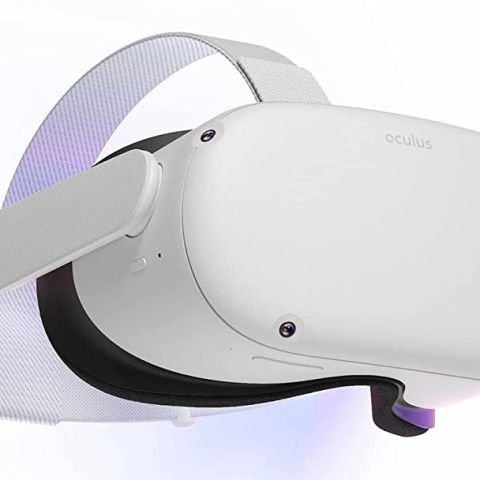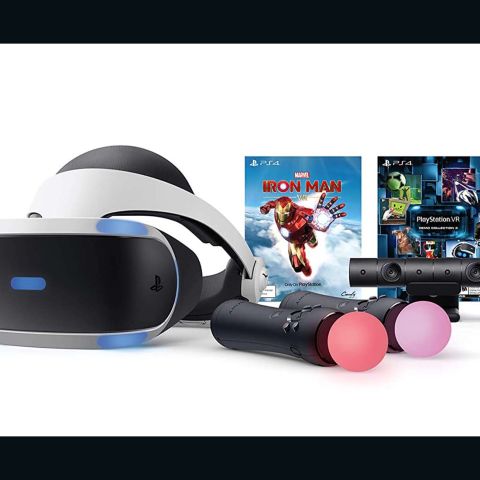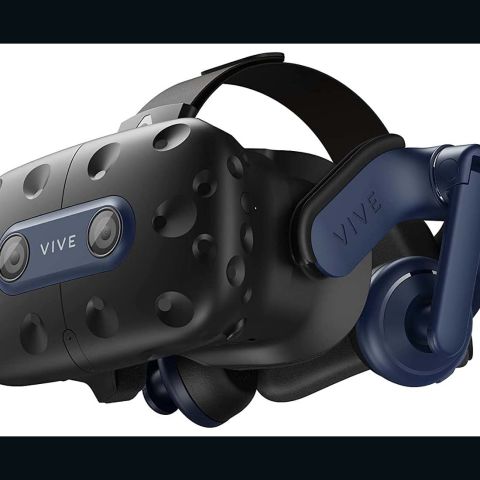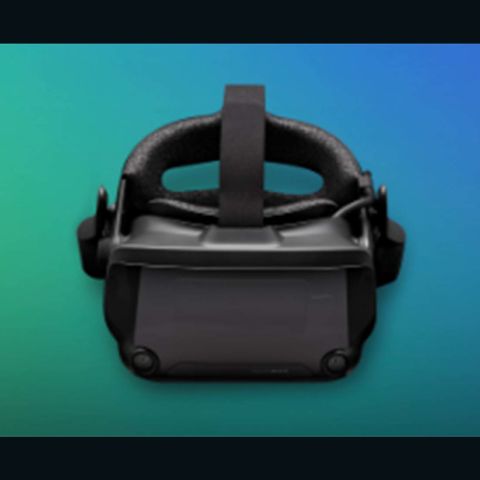A lot has changed with the Oculus Quest 2 virtual reality headset since its initial release in 2020. Besides its rebranding to the Meta Quest 2, there have been significant software upgrades including better refresh rates as high as 120Hz, upgraded hand tracking, wireless PC connectivity and voice commands.
But here’s what hasn’t changed: Between its affordable price, ease of use and sheer fun factor, the Meta Quest 2 has remained the most popular VR headset out there. Available for $299 with 128GB of storage or $399 with 256GB, this standalone virtual reality headset includes one of the biggest and best libraries of VR games and apps available, and is a breeze to set up — even if you’re new to VR. After living with the Meta Quest 2 for nearly a year, here are our thoughts on why it’s still the virtual reality headset most people should buy.
$299 at Amazon

The Meta Quest 2 is the most popular and accessible VR headset on the market today. A minimalistic and comfortable design, respectable battery life, great software and approachable price makes this the best VR headset for most people.
What we liked
Smart design, great comfort and easy setup
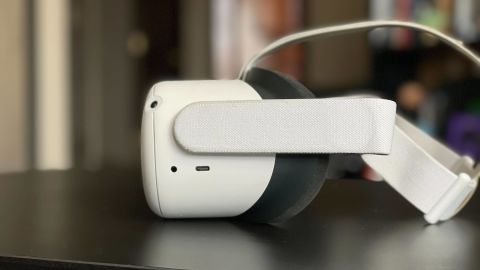
Out of the box, the Meta Quest 2 immediately presents a minimalistic yet accessible design. Opening the package reveals the headset itself, a USB-C charging cable/brick combo, straps and Meta Touch Controllers with batteries included. Buyers who require eye glasses will be happy to know that glasses spacers come in the box as well.
A reverse colorway from the original all-black Quest released in 2019, the all white Meta Quest 2 does feature some aesthetic differences. The exterior outer shell is completely hard plastic instead of the cloth-like material of its predecessor. That extends to the stretchable fabric that feels more comfortable than the elastic-feeling strap that nearly covered the back of user’s heads on the previous model.
All of this leads to a comfortable headset that’s actually lighter than the Quest 1 despite the increase in both power and functionality. Once you place the Quest 2 on your head, all you have to do is push the power button on the right hand side and sign in through Facebook (more on why that’s a problem later). Though there’s a 3.5mm headphone jack on the left side for headphones and ability to use Bluetooth earbuds (albeit with some lag issues), the built-in speakers are more than good enough. Volume controls are easily accessible on the bottom right side of the headset as well. Next to the headphone jack is a USB-C port that’s used for both charging and connecting the headset to a VR-ready desktop or laptop.

No matter how long our VR sessions, the headset never felt uncomfortable. However, be warned: Playing games that feature intensive movements or exercise apps are definitely going to result in a lot of sweating. Overtime, prolonged sweat will have the face cushion smelling like overused gym socks that haven’t been washed. Therefore, it’s best to either purchase a silicone cover or be prepared to keep a healthy supply of antibacterial wipes. Despite the light weight, the Meta Quest 2 feels durable enough to take a few bumps. Just be mindful that the white plastic may show noticeable scuffs through wear and tear over time.
Part of what sets the Quest 2 apart from other top VR headsets is that it’s a breeze to set up, and is a fully standalone device that doesn’t require a computer. Meta’s Guardian system creates a virtual playspace in your home, as it allows you to draw a border around yourself and be notified if you step outside of it. And thanks to the handy passthrough cameras, you can instantly see what’s happening around you in the real world with a quick double-tap of the headset (or when you step outside of your Guardian zone. Due to the four camera sensors on the headset, there’s no need to set up external sensors to start playing.
Intuitive controllers and lots of great features

The Meta Touch Controllers are the best input devices in VR today by far. Even with an AA battery inserted in each controller, they feel relatively weightless. From the analog sticks to face buttons and triggers, the controllers always felt comfortable. Whether we were performing wide swinging motions in Beat Saber or mowing down infected villagers in Resident Evil 4, the Touch Controllers provided an intuitive experience.
The haptic feedback isn’t as good as what you’ll find on consoles like the Nintendo Switch or PS5, but they do well enough in making hand movement feel immersive. Firing guns feels great, hitting boxing targets in Supernatural gives a sweet confirmation rumble and slicing a lightsaber in Vader Immortal: A Star Wars VR Series is as close to reality as possible due to the well implemented haptic feedback. Though the battery life on the Quest 2 itself isn’t the best, the Touch Controllers can last quite a while.

Taking things even further is how well hand tracking has improved since the original Quest. Using just your hands for controlling games like Cubism or Unplugged: Air Guitar in addition to apps like Virtual Desktop is a technological leap that simply has to be experienced. The recent Hand Tracking 2.0 updated further enhanced these capabilities with perks like better hand-to-hand movement without a break in tracking. Some games can even be controlled with Xbox or PlayStation controllers alongside mouse and keyboard. Voice controls are even available to open apps quickly. Though the voice controls aren’t absolutely perfect, opening apps through speech works more than not. The versatility in controller input on the Quest 2 is pretty outstanding.
Outside of input, the amount of things the Quest 2 is capable of can’t be understated. Utilizing Facebook log-in credentials for the headset makes it easy to find friends to connect with in the virtual world.
Gamers who want to share their experience with nearby friends or online can also cast their sessions to a television or live stream to platforms like Twitch. Again, there’s so much packed into the Quest 2. Part of enjoying the headset is learning all of the ins-and-outs of making usage more personable as time with it passes.
An incredible library of apps and games
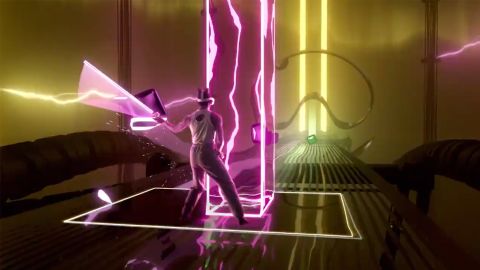
As of right now, there are a few hundred games downloadable for the Quest 2 with more on the horizon. From casual users to gaming enthusiasts or even individuals looking for alternative ways of exercising, the best Oculus Quest 2 games include something for everyone. Casual gamers will enjoy rhythm and puzzle games like Beat Saber or Tetris Effect: Connected alongside sports inspired titles such as Eleven Table Tennis VR or Creed Rise To Glory.
Shooters have probably made the best transition of any genre to VR, and the amount of options on the Quest 2 are incredibly impressive. Battle royale shooters like Population One hold up to popular console games like Fortnite or PUBG, but with a more immersive twist. Pistol Whip is a unique title that blends on-rails shooting with rhythm based gameplay. Then there are unique VR versions of contemporary hits and console classics from Superhot to Resident Evil 4.
Many of the games available on the Quest 2 are going to have users building up a light sweat. Those looking for intensive workouts should know that the headset features plenty of exercise-focused apps such as the incredibly popular Supernatural and FitXR. Both titles offer short try-out periods before requiring a monthly subscription that range between $10 and $20 a month.
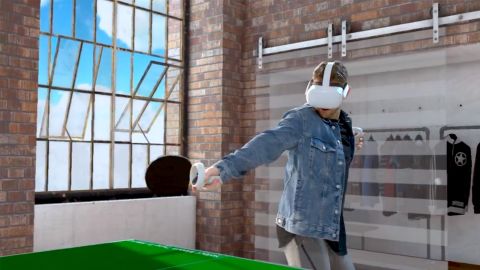
Games like Resident Evil 4 and Population One look amazing on the 1832 x 1920 per-eye screen, which now has up to a 120Hz refresh rate for extra-fluid gaming and navigation. Thanks to the Qualcomm Snapdragon XR2 mobile processor packed inside, we didn’t run into much slowdown — but it did happen occasionally. While the Snapdragon XR2 allows the Quest 2 to be fully standalone, it isn’t as powerful as what you’ll find in pricier PC-based headsets like the Valve Index or HTC Vive Pro 2.
Fortunately, Quest 2 users with a powerful enough gaming PC can utilize a Quest 2 Link cable, compatible USB-C cable or the wireless Quest Air Link feature to play higher-end VR games that are exclusive to computers. This gives access to bigger VR blockbusters like Half-Life Alyx and Star Wars Squadrons. Though Air Link and Quest Link both work well and are easy to set up via the Oculus PC app, it’s best to use the cable due to the lag that can come with going wireless. There are also plenty of non-gaming apps that users can toy around with on the Quest 2, including Bigscreen Beta, which provides the sensation of watching a movie inside a theater, or Virtual Desktop that allows users to use their desktop computer in VR.
What we didn’t like
Facebook login still required (for now)
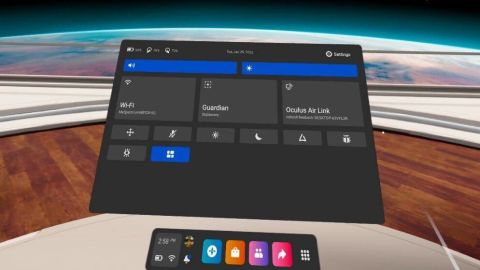
The Quest 2’s most controversial feature is that a Facebook account is required to even use it. Potential buyers who don’t already use the popular (and polarizing) social media network are simply going to have to create an account for now. There’s also the possibility of the Quest 2 being rendered useless if Facebook gets hacked or shut down. However, the most troubling aspect is that if a user’s Facebook account gets deleted, banned or hacked beyond repair, their entire purchased library of software is gone for good.
Meta announced late in 2021 that a future update will make it so that you don’t have to log-in to Facebook to use the headset. Though a date wasn’t given when the requirement would be phased out, it may be a big hurdle for some. According to reports, Meta CTO and Reality Labs head Andrew “Boz” Bosworth mentioned that the biggest hold up right now are data privacy regulations and how they affect changing the account structure on the headset. It’s been around half a year since the initial announcement, so hopefully this changes sooner than later.
Short battery life
Quest 2 users are going to probably get an average of two to three hours of battery life depending on what type of application is running. More complex VR experiences like Vader Immortal: A Star Wars VR Series or Resident Evil 4 are probably going to extract juice a bit faster due to those games’ visual fidelity. On the flip side, those watching videos or playing less demanding games will likely get a bit more mileage.
For safety purposes, this is probably for the better. According to reports, the recommended maximum time to be in a VR headset is about an hour anyway. The Quest 2 battery is around 3,640mAh in size, which means fully charging from empty should take around two or so hours. Those who use their headset more often than not are going to have to keep this on the charger regularly.
Bottom line

With a stunning look, a quality build that’s comfortable to wear for long lengths of time and various input options leading with the amazing Quest Touch controllers, the Oculus Quest 2 is truly something special. From Meta’s robust built-in app store to the many great PC-based experiences available through Quest Link, the selection of apps and games is one of the best you’ll find on any VR headset.
The $299 starting price makes this the most approachable high-quality VR headset on the market. To put things in perspective, the Quest 2 is a fraction of the price of premium VR headsets like the $799 HTC Vive Pro 2 or $999 Valve Index, both of which require you to have a powerful gaming PC. Sony’s PlayStation VR headset can be had for $349 at most retailers, but you’ll need a PlayStation 4 or PlayStation 5 to use one.
Just be mindful that using the Meta Quest 2 is going to require a Facebook login (for now), and that its short battery life can be somewhat frustrating. Despite those quirks, the Meta Quest 2 remains the best standalone VR headset you can buy right now.
How it compares to other top VR headsets
| Required system | None (optional PC compatibility via Quest Link) | PS4 or PS5 | PC (Nvidia GTX 1060/AMD RX 480 or better) | PC (Nvidia GTX 970 or AMD RX 480 or better) |
|---|---|---|---|---|
| Connection type | Fully wireless | Wired | Wired or wireless (via adapter) | Wired |
| Weight | 1.1 pounds | 1.3 pounds | 1.87 pounds | 1.78 pounds |
| Resolution | 1832 x 1920 per eye | 960 x 1080 per eye | 2448 x 2448 per eye | 1440 x 1600 per eye |
| Refresh rate | Up to 120Hz | Up to 120Hz | Up to 120Hz | Up to 144Hz |
| Storage | 128GB / 256GB | N/A | N/A | N/A |
| Battery life | 2-3 hours | N/A | N/A | N/A |
| Price |
$299 |
$349 |
$799 |
$999 |















































